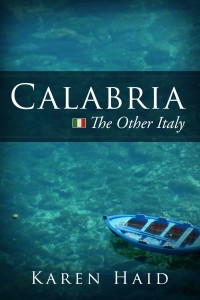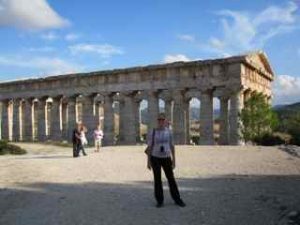THE BOOK COVER
PUTTING TOGETHER A BOOK for publication takes a lot of thought and requires many decisions. For obvious reasons, much care is given to the cover, but the interior layout, choice of fonts and typesetting is equally important as that’s where the reader ultimately will spend most of his time. The book cover, however, gives the first impression, sets the tone. I wanted to incorporate one of my photos. I had many to choose from—the mountains, the shore, the city, the countryside, the people, the food, the art… The difficulty would be selecting just one. For a standard tour book, Calabria has more than its share of beauty and thus where photos are concerned, there’s what an Italian would call l’imbarrazzo della scelta (literally, embarrassment of choice or more colloquially, a wealth of options). Notwithstanding, as my book is not a guide in the commercial sense, I didn’t want the cover to give the impression that it would be filled with typical recommendations and summaries. Rather, I wanted the cover to hint at a journey—whether it be my experience, the region’s historical odyssey, a contemporary story of the Calabrian people or the reader’s own ruminations. Thus, the boat, hovering off the shore of the fishing village named Chianalea in the town of Scilla.
THE ITALIAN FLAG
Adding the flag seemed a simple task, but oddly enough, the first proof featured a flag in which the three bands weren’t of equal size. The red looked shorter even though I was assured that all of the dimensions and pixels were perfectly correct. I somehow wasn’t seeing a correspondingly perfect rectangle on my computer screen, and printing it out, the image had the same lopsided look.
STRUGGLING WITH AN ILLUSION
So how was I to fix my flag? Shave a little off the white? Make the red a little bigger? It seemed risky and I was told that fixing problems of this nature was difficult and often impossible. It was then that I reflected on the ancient Greeks and their temples. Although only one column still stands in Calabria, that being in the town of Crotone, a few thousand years ago, grand temples were found all along the coast, when the region was part of Magna Graecia or Greater Greece.
THE GREEKS FIGURED IT OUT 2500 YEARS AGO
But how was this to be accomplished on the little flag of my book cover? A wavy flag was suggested, but aside from the fact that many of them already had larger white sections, I wasn’t crazy about that particular look with the overall design. In the end, the solution was not as technical as it may have been for the Greeks, but just as matters of proportion were decided so long ago, the eye was the final arbiter. A simple white border resolved the issue, together with a flag whose white panel was a bit weathered so as not to unite too forcefully with the outer edge, thereby avoiding any tricks for the eyes.
FROM COLUMNS TO PIXELS
In its present form, the Tricolore was officially adopted as the flag of the Italian Republic in 1948. This long, narrow peninsula with an even longer history is really a very young country. Calabria lies at its very tip—a territory that has kept its head above water, at times in its own little fishing boat, occasionally in larger vessels, and often giving way to the ships of others. Its story spans from before the Greeks erected their temples until today, when there’s just one Doric column left standing, to which, rest assured, countless pixels have been dedicated.
Do you like the book cover? Now find out what’s inside this Calabria book in an expanded table of contents. Read what others have to say in Book Reviews and Interviews.
Calabria: The Other Italy is widely available in paperback and electronic versions, and it makes a great gift!



Comments 8
Beautiful—have friends who would love to read this in Italian–
Author
Thanks, Barbara! I’m planning on posting many photos, which might interest your Italian-speaking friends. In addition, I hope my book will also be published in Italian.
Ciao!
Love your blog, now that we’ve found it. Really looking forward to the book!
Author
Thanks! I’m looking forward to seeing it in print, too. It should be available in late December/early January. I will have information on the site when it’s ready and will continue to put up new posts on my blog, so check back soon!
Ciao Karen,
thank you for commenting on my blog, so I found you and your book!
Congratulations to your publication. It sounds very interesting. I need to have one!
Is it available in bookstores in Calabria or at Lamezia airport? I love the photo you’ve chosen for your book. Me too, I have to answer the question often: “Why Calabria?”.
And the colour of the sea (and its temperature) I guess, explains it best! Well chosen.
Can’t wait to get another English book about Calabria in my hands.
Greetings,
Susan
Author
Hi Susan,
Thanks for your kind words. I hope my book will help fill the informational void as well as the misinformation with regard to Calabria. I just approved the physical proof and so now it’s just a matter of time to print the initial copies. It’s “print on demand”, which means one copy or multiple copies will be printed as requested. The book will be on major Internet sites (such as Amazon or Barnes and Noble), but that may take several weeks. I haven’t ever done this before, so I’m not sure about the timeline. There is a printing facility in Great Britain, which will make the shipping to Europe more reasonable. (I, of course, can mail copies from the U.S., but I’m hoping that the international online retailers will make it more cost effective for Italy and that European shops will be able to find it on Bowker’s “Books in Print” database and order from there.)
As for having copies in Calabria, I am hoping to have some in the National Archeological Museum in Reggio. Your suggestion of having it available at the Lamezia airport is excellent, and I hope I will also be able to make that happen. (Any further contact information or suggestions on that score would be greatly appreciated.)
I’m also in the process of converting the file to an e-book, which of course would make it more easily available, but personally, I like to have an “old-fashioned” book in my hands. And after a couple of years working on the computer screen, it was really wonderful to have a hard copy to look at!
Thanks again for your interest. If everything goes smoothly, books should be ready in a couple of weeks, and I’ll let you know.
All the best,
Karen
I did enjoy reading about what you were trying to convey, (successfully, I might add), through the cover picture of the boat! In addition to all that, ……… it is a BEAUTIFUL picture!
Author
Thanks! The picture was taken in Scilla (chapter 12) – from the castle looking down to the fishing village that’s called Chinalea.